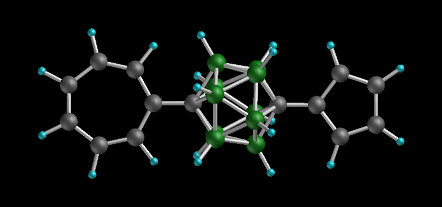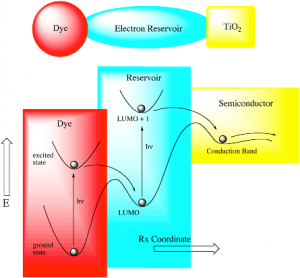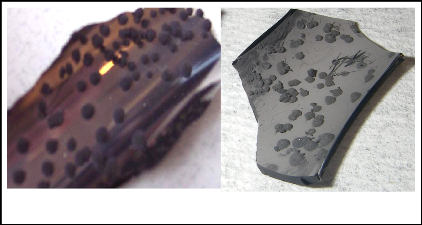Non Linear Optical Materials from Clusters and Rigid Molecules
 In an interesting area of our work, we are exploring the chimistry of main group polyhedral clusters. The field spans the boundaries of traditional areas of inorganic, organometallic, and materials chemistry. Specifically, our research has focused upon the study of polyhedral bases as new nonlinear optical compounds, the photochemical reactions of clusters and the use of cluster and rigid molecules as molecular building blocks in the directed formation of nanoscale architectures.
In an interesting area of our work, we are exploring the chimistry of main group polyhedral clusters. The field spans the boundaries of traditional areas of inorganic, organometallic, and materials chemistry. Specifically, our research has focused upon the study of polyhedral bases as new nonlinear optical compounds, the photochemical reactions of clusters and the use of cluster and rigid molecules as molecular building blocks in the directed formation of nanoscale architectures.
New Generation of Sensors
We are developing a new generation of solid state sensors with exceptional response and selectivity properties based upon the use of modified piezoelectric solid state oscillators, including functionalized Quartz Crystal Microbalances (QCM). Sensors based upon the response of such piezoelectric devices are expected to provide a unique platform for the selective detection of key target molecules, with ppb sensitivity and exceptional selectivity, similar to that found in immunoassay, and deliver devices that are inexpensive, robust, rapidly modified to new applications and broadly applicable to a variety of environmental, biomedical and threat-responses.
Piezoelectric (PZ) materials have been extensively used in a variety of analytical applications. By modifying the surface chemistry of these solid state materials through functionalization chemistry using 3D nanoporous, polymeric and nanostructured materials, We are developing transformational PZ-based designs, that are providing the potential for the development of new versatile, exceptionally sensitive and chemically selective sensors that yield real-time information via robust and inexpensive systems.
In this work we are collaborating with researchers at the Upstate Medical University, Iowa State University College of Veterinary Medicine, the Universidade Technologicia a Federal do Parana (UTFPR, Brazil), MolecuSense Inc., and Caladan Technologies, as well as other research groups at Syracuse University.
New Photovoltaic Designs
A limiting factor in current  Dye sensitized solar cells is the use of a single band gap dye. Much like multi P/N junction thin films use many cells absorbing at different wavelengths, it is thought that a DSSC could use a multiple band gap dye system to absorb across a broader spectrum. The current single band gap design creates a problem by needing an electron of at least 1.7 eV (729 nm) to be useful with a titanium dioxide semiconductor. The ultimate goal is to expand the usable region of light as much as possible.
Dye sensitized solar cells is the use of a single band gap dye. Much like multi P/N junction thin films use many cells absorbing at different wavelengths, it is thought that a DSSC could use a multiple band gap dye system to absorb across a broader spectrum. The current single band gap design creates a problem by needing an electron of at least 1.7 eV (729 nm) to be useful with a titanium dioxide semiconductor. The ultimate goal is to expand the usable region of light as much as possible.
We are also developing new approaches for photovoltaic systems based upon functionalized hex-boron nitride nanosheets. These have shown great promise for new light-harvesting systems.
Nanostructures
 One aspect of our work focuses upon the development of new solid state boron-based materials as thin films, nanoparticles and nanotubes. These materials display an enormous range of physical and chemical properties that have direct application to many areas. We have recently discovered several new chemical pathways for the formation of thin films of metal borides along with the first reported pathways for the fabrication of boron-based nanotubes and nanorod structures. These unique structures, for instance are readily prepared, are remarkably uniform, and display very large aspect ratios.
One aspect of our work focuses upon the development of new solid state boron-based materials as thin films, nanoparticles and nanotubes. These materials display an enormous range of physical and chemical properties that have direct application to many areas. We have recently discovered several new chemical pathways for the formation of thin films of metal borides along with the first reported pathways for the fabrication of boron-based nanotubes and nanorod structures. These unique structures, for instance are readily prepared, are remarkably uniform, and display very large aspect ratios.
